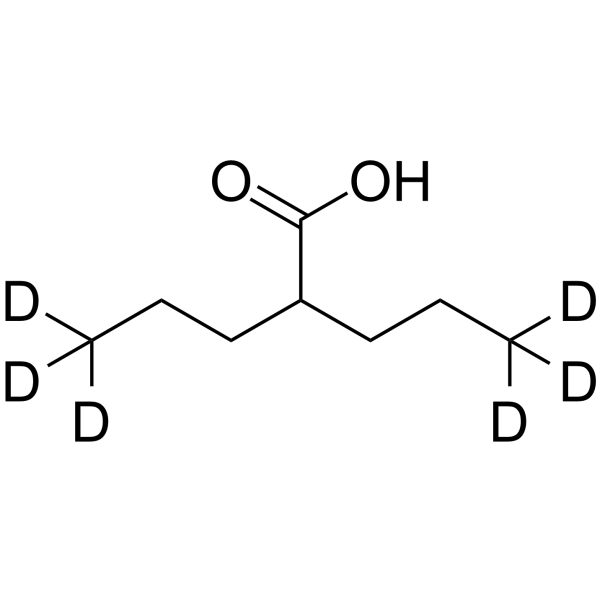Valproic acid-d6 |
| Catalog No.GC64378 |
L'acide valproÏque-d6 (VPA-d6) est l'acide valproÏque marqué au deutérium. L'acide valproÏque (VPA; acide 2-propylpentanoÏque) est un inhibiteur de l'HDAC, avec une IC50 comprise entre 0,5 et 2mM, inhibe également l'HDAC1 (IC50, 400μM) et induit la dégradation protéasomique de l'HDAC2. L'acide valproÏque active la signalisation Notch1 et inhibe la prolifération dans les cellules du cancer du poumon À petites cellules (SCLC). Le sel de sodium de l'acide valproÏque est utilisé dans le traitement de l'épilepsie, du trouble bipolaire et de la prévention des migraines.
Products are for research use only. Not for human use. We do not sell to patients.

Cas No.: 87745-18-4
Sample solution is provided at 25 µL, 10mM.
Valproic acid-d6 (VPA-d6) is the deuterium labeled Valproic acid. Valproic acid (VPA; 2-Propylpentanoic Acid) is an HDAC inhibitor, with IC50 in the range of 0.5 and 2 mM, also inhibits HDAC1 (IC50, 400 μM), and induces proteasomal degradation of HDAC2. Valproic acid activates Notch1 signaling and inhibits proliferation in small cell lung cancer (SCLC) cells. Valproic acid sodium salt is used in the treatment of epilepsy, bipolar disorder and prevention of migraine headaches[1][2].
Stable heavy isotopes of hydrogen, carbon, and other elements have been incorporated into drug molecules, largely as tracers for quantitation during the drug development process. Deuteration has gained attention because of its potential to affect the pharmacokinetic and metabolic profiles of drugs[1].
[1]. Russak EM, et al. Impact of Deuterium Substitution on the Pharmacokinetics of Pharmaceuticals. Ann Pharmacother. 2019;53(2):211-216.
[2]. Valproic acid, et al. Histone deacetylase is a direct target of valproic acid, a potent anticonvulsant, mood stabilizer, and teratogen. J Biol Chem. 2001 Sep 28;276(39):36734-41.
[3]. Han BR, et al. Valproic acid inhibits the growth of HeLa cervical cancer cells via caspase-dependent apoptosis. Oncol Rep. 2013 Dec;30(6):2999-3005.
[4]. Zhang ZH, et al. Valproic acid inhibits tumor angiogenesis in mice transplanted with Kasumi 1 leukemia cells. Mol Med Rep. 2013 Nov 28.
[5]. Cohen OS, et al. Acute prenatal exposure to a moderate dose of valproic acid increases social behavior and alters gene expression in rats. Int J Dev Neurosci. 2013 Dec;31(8):740-50.
[6]. Avery LB, et al. Valproic Acid Is a Novel Activator of AMP-Activated Protein Kinase and Decreases Liver Mass, Hepatic Fat Accumulation, and Serum Glucose in Obese Mice. Mol Pharmacol. 2014 Jan;85(1):1-10.
[7]. Platta CS, et al. Valproic acid induces Notch1 signaling in small cell lung cancer cells. J Surg Res. 2008 Jul;148(1):31-7.
Average Rating: 5 (Based on Reviews and 1 reference(s) in Google Scholar.)
GLPBIO products are for RESEARCH USE ONLY. Please make sure your review or question is research based.
Required fields are marked with *




















